Pheidole cicatricosa Stitz - new status
 MAJOR MAJOR  MINOR
MINOR Type location Algeria (Pheidole
pallidula
Nyl., v. cicatricosa n. v., Stitz,
1917: 340, illustrated, major & minor workers; synonymized with pallidula
by Collingwood, 1978: 68, without notes; new status here) from Oued
Agelil, 30.i.1914, collected by V Geyer - see below. Type location Algeria (Pheidole
pallidula
Nyl., v. cicatricosa n. v., Stitz,
1917: 340, illustrated, major & minor workers; synonymized with pallidula
by Collingwood, 1978: 68, without notes; new status here) from Oued
Agelil, 30.i.1914, collected by V Geyer - see below.
Primary homonym tristis (Pheidole
pallidula Nyl., v. tristis n. var., Forel,
1907b: 204, worker [not queen]; Santschi, 1908: 521, major, queen
& male) from Tunisia;
collected at Kairouan, by Dr F Santschi - on linked pages; preoccupied
name. Name tristis
preoccupied by Pheidole tristis
(F Smith, 1858b: 132; combination in Pheidole
by Mayr, 1886c: 360) type location Brazil (type images see http://www.antweb.org/specimen.do?name=casent0901573).
Junior synonym recticeps (Pheidole
pallidula
Nyl subsp. tristis For, var. recticeps n. var., Forel, 1909e:
391;
Menozzi: 1932e, 452, major & minor workers; include the capensis of Emery, 1891: 13, given
by Emery, 1915j: 227; new synonymy
here) from Egypt,
collector M. Ed. Wundsam -on linked pages.
Note: Antweb and AntCat have the Forel (1907b) types
under the name "Pheidole tasdelenia".
The species status is not explained but according to the "Taxonomic
history (provided by Barry Bolton, 2013)" the nomenclature is Pheidole pallidula tasdelenia
Özdikmen, 2010b: 805. After correctly drawing attention to the
prior named F Smith species, that author stated the subspecies Pheidole pallidula tristis Forel
1907 "has no synonym". Santschi (1936c), however, had commented
that, apart
from the paler
colour, cicatricosa and tristis were identical, thus,
effectively synonymizing them.The name recticeps, as a trinomial, was an
unavailable name (Bolton, 1995: 329), albeit raised by Menozzi (1932e:
452) to Pheidole pallidula
var. recticeps, has no
validity. Hence, I use the specific name P. cicatricosa. P. tasdelenia
should be seen as unnecessary.
Reference: Özdikmen, H. 2010b. New names for the
preoccupied specific and subspecific epithets in the genus Pheidole Westwood, 1839
(Hymenoptera: Formicidae). Munis
Entomology and Zoology 5
:804-806. [2010-06].
|
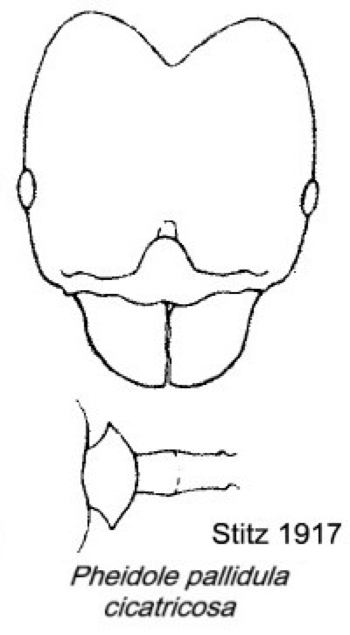 Stitz (1917: 340)
briefly described a new variety of Pheidole
pallidula Nyl. v. cicatricosa n. v., his description is at Stitz (1917: 340)
briefly described a new variety of Pheidole
pallidula Nyl. v. cicatricosa n. v., his description is at  . He noted only that the postpetiole had
lateral points; the propodeum had short teeth; 1 major and 4 minors,
from Algeria, Temassinin, 30.i.1914, collector von Geyr. . He noted only that the postpetiole had
lateral points; the propodeum had short teeth; 1 major and 4 minors,
from Algeria, Temassinin, 30.i.1914, collector von Geyr.
|
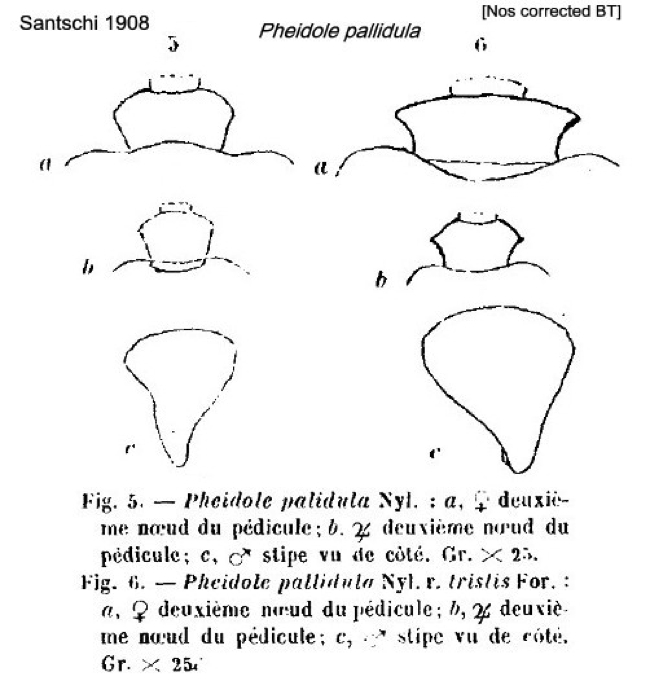 Forel's
(1907b) description of the tristis
worker was simply - TL 2.6-2.8 mm, dark brown, mandibles, antennae and
tarsi yellow-brown, otherwise identical to the type pallidula,
not rare in the Atlas; Santschi's (1908) description of tristis,
with comparative illustrations [note the illustration was wrongly
numbered], is at Forel's
(1907b) description of the tristis
worker was simply - TL 2.6-2.8 mm, dark brown, mandibles, antennae and
tarsi yellow-brown, otherwise identical to the type pallidula,
not rare in the Atlas; Santschi's (1908) description of tristis,
with comparative illustrations [note the illustration was wrongly
numbered], is at  . Forel's (1909e)
description of recticeps,
is at . Forel's (1909e)
description of recticeps,
is at  . Emery (1915j) gave an
illustrated note on recticeps, this is at . Emery (1915j) gave an
illustrated note on recticeps, this is at  . Santschi (1936c) gave a short note, this
is at . Santschi (1936c) gave a short note, this
is at  . .
Forel (1907b: 204) had denoted "Pheidole pallidula
Nyl., v. tristis n.var. worker [note in original this
is denoted as a Queen but the size is too small] - TL 2.6-2.8 mm; dark
brown, mandibles yellow-brown as are the antennae and tarsi. Kairouan
(Dr Santschi); this variety of Ph. pallidula well deserves to
be named. It is not rare in the Atlas; the rest of the characters are
identical to pallidula in. sp.". Forel's (1909e) description of
recticeps has - soldier differs from tristis
by a paler reddish colour, and especially by the slightly convex sides
to the head, which is rectangular-rounded, slightly wider behind than
in front; the worker has less obvious differences in head shape but is
smaller than tristis at TL 2.2 mm. The situation was confused
somewhat by Emery's statement (1915j) on the remarkably large, dark
form from Tunisia and Algeria, described by Forel as tristis.
However, he went on to express the opinion that Santschi had confused
two distinct forms, tristis Forel and recticeps Forel,
under the single name tristis. The only Santschi paper referred
to by Emery, however, was published in 1908 and pre-dates the Forel
(1909e) description of recticeps.
Even allowing for the brevity of Stitz's note, the
features and drawing, appear to be a close match for the tristis type (shown below). Bpth
are matched by the recticeps
type and the fresh specimens from Egypt (on the linked pages). Santschi (1936c) commented that, apart
from the paler colour, cicatricosa and tristis were identical. He
noted also that tristis had a wider postpetiole than the type pallidula.
Menozzi (1940: 268) reporting Pheidole pallidula var. recticeps
For. from Tripolitana, lists major & minor workers from Tagiura,
and refers to Zavattari (p 277) [Prodromo della fauna della Libia,
Pavia, 1934] as giving this form only from Cirenaica & Fezzan.
|
Egypt records - Pheidole pallidula ssp tristis
var recticeps Forel (1909e: 391), collected at Cairo, by Ed.
Wundsam, soldier & workers passed to Forel at Ghadamès (Sahara) by
Ali Ben Belkassem; Pheidole pallidula recticeps Menozzi
- in HNS as Pheidole
pallidula var. recticeps Menozzi (1932e: 452, soldier
& worker); also record in Mohamed et al (2001). P.
pallidula was recorded by Forel (1907a) from Alexandria by Biró.
Wheeler & Mann (1916) reported it from Wadi Feran & Wadi
Gazelle, Sinai Peninsula. Donisthorpe (1942a) recorded var tristis
from Siwa, three soldiers & numerous workers; also var recticeps
(Forel; not in Bolton, 1995) Siwa & Bachrein; all collected by J
Omer-Cooper, July-August 1935; others from the same location were
listed by Donisthorpe (1947e).
Mohamad thesis (1979) had - P. pallidula recticeps
Fayium, 2.v.1952; Burg El-Arab (Alexandria), 17-18.iv.1953; Abu qir
(Alexandria), 19.iv.1953, 10.iv.1955; Alexandria,2.iii.1955; Gebel
Asfar (Qaliobyia), 20.iii.1955; El-Dekheila (Alexandria),8.iv.1955;
Cairo, 28.v.1955; Damanhour (Nile Delta),1.iv.1956; Benha,6.ii.1975;
Cairo, 2.vi.1975; Heliopolis (Cairo), 4.vii.1975; Siwa oasis (Western
desert), 13iv.1976; Tanta (Nile Delta), 7.xii.1977; El-Mahalla El-Kobra
(Nile Delta), 8.xii.1977; Kafr El-Sheikh (Nile Delta), 22.xii.1977 (Coll.Ain.)
|
 Photomontage
of the major worker of Pheidole pallidula
Nyl. v. cicatricosa n.v. of Stitz (1917: 340); from Algeria,
Oued
Agelil, 30.i.1914, collected by V Geyer. Photomontage
of the major worker of Pheidole pallidula
Nyl. v. cicatricosa n.v. of Stitz (1917: 340); from Algeria,
Oued
Agelil, 30.i.1914, collected by V Geyer.
|
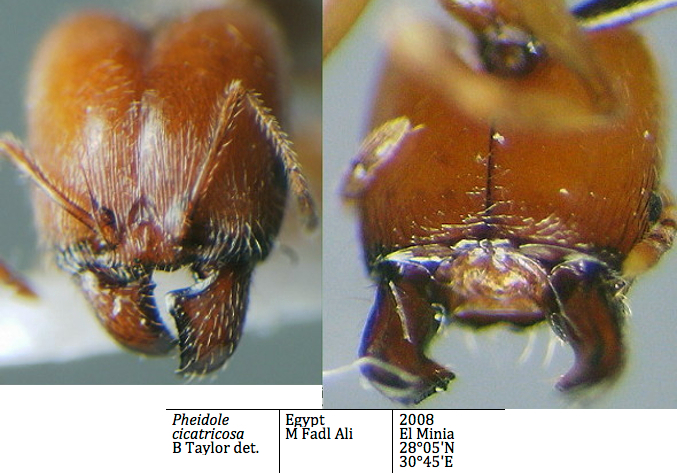 Comparision of the
heads
of
major workers of pallidula and cicatricosa, including
the hypostomal teeth arrangement. Comparision of the
heads
of
major workers of pallidula and cicatricosa, including
the hypostomal teeth arrangement.
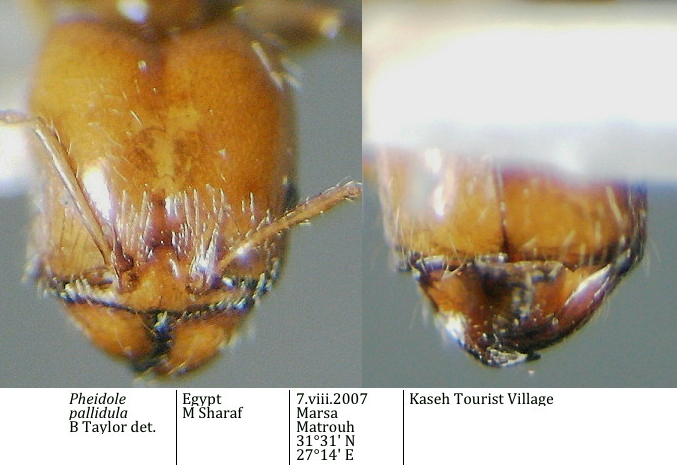
|
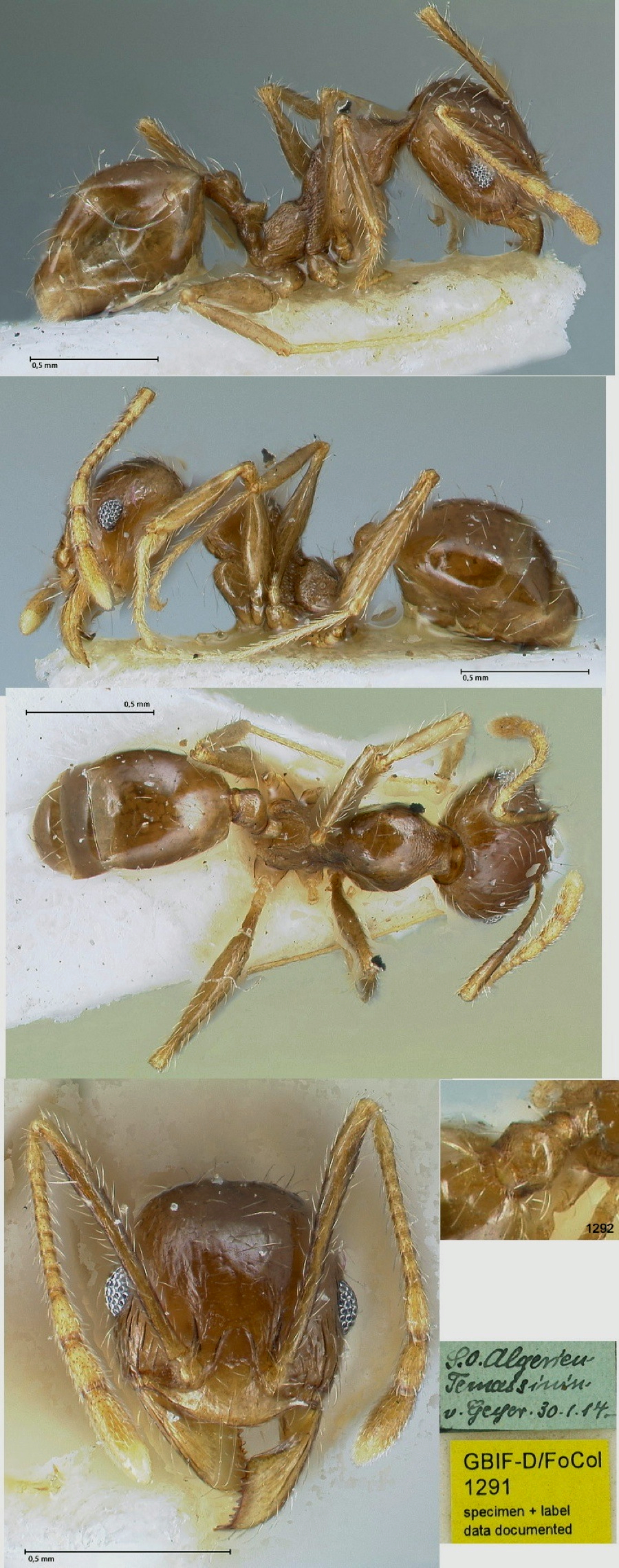 Photomontage
of the Pheidole pallidula
Nyl. v. cicatricosa n.v. minor worker from Algeria,
Temassini, 30.i.1914, collected by V Geyer; of Stitz (1917: 340). Photomontage
of the Pheidole pallidula
Nyl. v. cicatricosa n.v. minor worker from Algeria,
Temassini, 30.i.1914, collected by V Geyer; of Stitz (1917: 340).
|
With the availability of fresh specimens
from Egypt and Spain, also a minor from Mali, the link pages give fresh
photographs and descriptions of
Major
workers; Minor
workers
|
Oxford University Museum
specimens
Pheidole tristis
B Taylor det.
|
Egypt
M Fadl Ali
|
2008
El Minia
28°05'N
30°45'E
|
major & minor
workers
|
6
|
 |
Pheidole tristis
B Taylor det.
|
Egypt
M Sharaf
|
4.v.2003
Zaranik
30°39' N
32°53' E
|
North Sinai, Abumadi
major
|
2
|
 |
Pheidole tristis
B Taylor det. |
Mali
David King
King 46
|
25.viii.2007
Bamako
12°37.481' N
8°00.27' W
|
P323 m asl; foraging
on wall of outside stairwell
minor
|
1
|
 |
Pheidole tristis
B Taylor det. |
Spain
X Espadaler
|
27.x.2008
Barcelona
41.3833333 N
2.1833333 W
|
Garden Costa i
Llobera
major & minor workers
|
4
|
 |
|
|